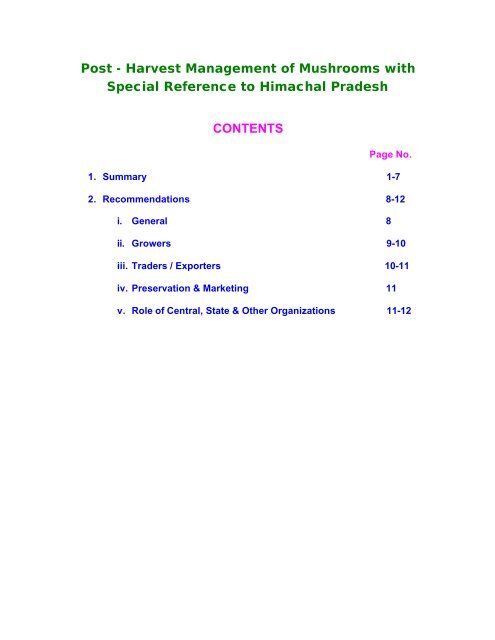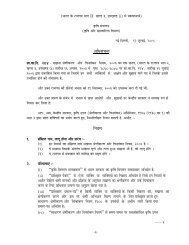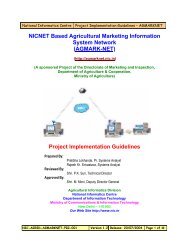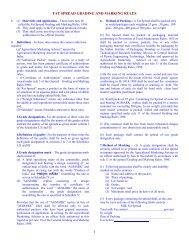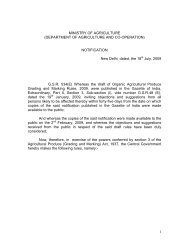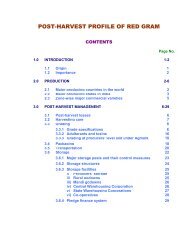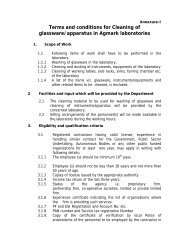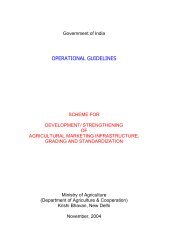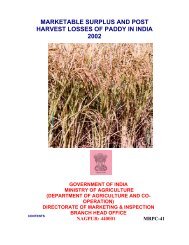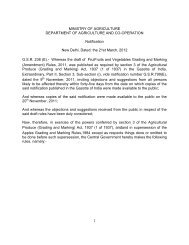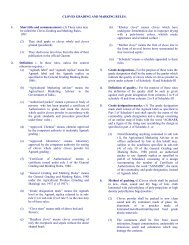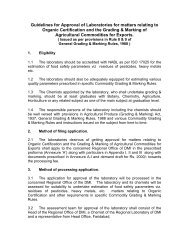Post - Harvest Management of Mushrooms with Special ... - Agmarknet
Post - Harvest Management of Mushrooms with Special ... - Agmarknet
Post - Harvest Management of Mushrooms with Special ... - Agmarknet
Create successful ePaper yourself
Turn your PDF publications into a flip-book with our unique Google optimized e-Paper software.
<strong>Post</strong> - <strong>Harvest</strong> <strong>Management</strong> <strong>of</strong> <strong>Mushrooms</strong> <strong>with</strong><br />
<strong>Special</strong> Reference to Himachal Pradesh<br />
CONTENTS<br />
Page No.<br />
1. Summary 1-7<br />
2. Recommendations 8-12<br />
i. General 8<br />
ii. Growers 9-10<br />
iii. Traders / Exporters 10-11<br />
iv. Preservation & Marketing 11<br />
v. Role <strong>of</strong> Central, State & Other Organizations 11-12
SUMMARY<br />
In Himachal Pradesh, the commercial production <strong>of</strong> mushroom<br />
started during late sixties on an experimental basis by<br />
Dr.E.F.K.Mantel, an Agricultural Scientist under FAO Programme.<br />
The College <strong>of</strong> Agriculture, Solan took the lead and provided<br />
initial research facilities. Sri Amarinder Singh was the pioneer<br />
grower to venture in the field. The raw materials used were<br />
wheat straw, spent brewer's grain from Solan distillery, wheat bran, super<br />
phosphate, murate <strong>of</strong> potash and urea. The spawn was provided by agriculture<br />
college, Solan, and spent mushroom compost, sand, saw dust and loamy soil<br />
formed the casings. Around early seventies some growers <strong>of</strong> Chail and Kasauli<br />
produced few hundred kgs. <strong>of</strong> mushroom per day which was canned by TEGS<br />
Mushroom.<br />
Oyster mushroom<br />
cultivation<br />
Button mushroom<br />
cultivation<br />
Himachal Pradesh emerged as a major state <strong>of</strong> mushroom cultivation<br />
where small growers, co-operative growers societies, big farmers and some<br />
corporate organisations are engaged in production. Since, it is an ideal state<br />
for development <strong>of</strong> mushroom industry, several commercial units in<br />
organised/corporate sector have come up in Himachal Pradesh. The major<br />
growing districts are Solan, Shimla, Kangra, Mandi, Kullu and Sirmaur. Due to<br />
improved quality <strong>of</strong> compost, better market facilities, small and medium sized<br />
units have been established around Shimla and Solan. However, some limiting<br />
factors such as inadequate financial facilities, high cost <strong>of</strong> transportation in hilly<br />
areas, inadequate post harvest infrastructure, rising cost <strong>of</strong> inputs are coming<br />
in way <strong>of</strong> expected progress.<br />
Increased productivity demands proper post harvest<br />
infrastructure to increase shelf life and marketability. Since<br />
mushrooms are perishable and delicate in nature, these cannot<br />
be kept afresh for more than 24 hrs. After the maturing <strong>of</strong> the<br />
fruiting body, the deterioration starts <strong>with</strong> the formation <strong>of</strong><br />
brown colouration and hence the quality deterioration and loss<br />
<strong>of</strong> marketability. To overcome this problem, specially during<br />
peak season, suitable post harvest management/practices are<br />
to be followed to increase the shelf life and marketability <strong>of</strong><br />
mushrooms. Initial steps are, proper harvesting time and<br />
stage. <strong>Mushrooms</strong> are generally harvested after 3 weeks <strong>of</strong><br />
casing. Button mushrooms are to be harvested when the CAP<br />
<strong>Harvest</strong>ing <strong>of</strong><br />
mushroom<br />
size is 30-45 mm in diameter, whereas Oyster mushroom is harvested when<br />
the fruiting body becomes curled under edges and well formed gills.<br />
1
POST HARVEST PRACTICES OF MUSHROOM<br />
HARVESTING<br />
GRADING<br />
PRE COOLING<br />
(1.7 0 C -7.2 0 C )<br />
FRESH<br />
PROCESSED<br />
(CANNING , DRYING, PICKLING, I.Q.F)<br />
PACKING<br />
POLYPOUCHES<br />
CARTONS<br />
TRANSPORTATION<br />
BY ROAD<br />
(ORDINARY, REFRIGERATED)<br />
BY AIR<br />
MARKETING<br />
DOMESTIC TRADE<br />
EXPORT<br />
MAJOR MARKETS<br />
(DELHI, PUNE, CHANDIGARH,<br />
MUMBAI)<br />
MAJOR MARKETS<br />
( U.S.A, SWITZERLAND<br />
,FRANCE, GERMANY,<br />
NETHERLAND )<br />
2
Grading <strong>of</strong> mushrooms is important for marketing. Generally, the grading<br />
is done by segregation <strong>of</strong> mushrooms into various grade standards as per<br />
market demand. For example button mushrooms are graded into Grade<br />
A, B and C. The Directorate <strong>of</strong> Marketing & Inspection (D.M.I.) had<br />
formulated the grade standards for dried edible mushrooms as<br />
<strong>Mushrooms</strong> Grading & Marking Rules, 1972 under the Agricultural<br />
Produce (Grading & Marking) Act,1937.<br />
Other step is pre-cooling wherein the produce is kept in a plastic<br />
bag and stored in cooling unit. Vacuum cooling is another cooling system<br />
where water existing in cell walls and inter hyphal spaces <strong>of</strong> produce is<br />
evaporated under pressure which lowers the temperature. But it is cost<br />
oriented system and involves inevitable loss <strong>of</strong> fresh weight.<br />
Packing is essential to protect the mushroom during marketing. It<br />
is generally packed in polythene bags <strong>of</strong> 250 gm-400 gms for local<br />
markets. For long distance transport, pulp board punnets wrapped <strong>with</strong><br />
PVC films should be used instead <strong>of</strong> polythene bags. Sometimes, precooled<br />
mushrooms are packed in insulated containers having ice in it, so<br />
that <strong>Mushrooms</strong> remain fresh, healthy during long transport.<br />
Mushroom packing in<br />
polypouches<br />
Mushroom packing<br />
in cartons<br />
The effect <strong>of</strong> pre cooling is lost partially in post pre-cooling period.<br />
Hence, for long distant transport, speedy refrigerated transport system is<br />
essential in which CFB cartons containing polythene pouches <strong>of</strong><br />
mushrooms may be transported by refrigerated trucks. For short<br />
distance markets, precooled fresh mushrooms are despatched in wooden<br />
boxes <strong>with</strong> sufficient crushed ice in polypacks. For local retailer’s markets<br />
mushrooms are packed in polypouches and despatched by cycle, cyclerickshaws,<br />
auto-rickshaws etc.<br />
<strong>Mushrooms</strong> are marketed as fresh, dried and preserved.In<br />
Himachal Pradesh, it is mainly marketed in fresh form. The major<br />
quantity <strong>of</strong> Himachal mushroom is consumed in plains <strong>of</strong> Punjab,<br />
Haryana and Delhi during Oct-Nov and Feb-May. During Dec-January, the<br />
produce <strong>of</strong> plain areas also arrives in markets. The middlemen and<br />
commission agents collect produce from growers and despatch to<br />
regulated markets/satellite markets or markets outside the state. From<br />
consumption trend, it is seen that people <strong>of</strong> high income group and<br />
restaurants catering them are main buyers <strong>of</strong> mushrooms.<br />
3
Fresh mushroom<br />
Dried mushroom<br />
According to the findings <strong>of</strong> a survey by Mac-plan India, about<br />
55% <strong>of</strong> the households out <strong>of</strong> 354 samples from 29 major cities <strong>of</strong> 15<br />
states <strong>of</strong> the country were the regular consumers. Highest level <strong>of</strong><br />
consumption was about 60% in the Northern Region, while the lowest<br />
was 20% in the Eastern Region. Consumers <strong>with</strong> income ranging<br />
between Rs.10,000 and Rs. 35,000/- were the major consumers i.e.,<br />
between 19-22%. Supply and Price trend <strong>of</strong> mushrooms were<br />
inconsistent affecting consumer demand. It is estimated that demandsupply<br />
gap by 2006 will be around 1,26,000 MT/year which clearly<br />
denotes a vast scope to expand mushroom enterprises.<br />
Due to highly perishable nature preservation <strong>of</strong> mushrooms is<br />
necessary to minimise the post harvest losses,. For this, the processing<br />
techniques such as Canning, Individual Quick Freezing (I.Q.F.), Vaccum<br />
Freeze Drying (VFD), Drying, Vaccum Drying, Pickling, Steeping<br />
Preservation, Radiation Preservation etc. have been developed. These<br />
are used on the basis <strong>of</strong> their merits per se market demand and end<br />
use.<br />
Canning is an established process <strong>of</strong> preserving mushroom pieces<br />
in brine, butter, oil, vinegar etc. It involves six basic operations like<br />
cleaning, blanching, can filling, sterilization, cooling and labelling.<br />
Through all these operations, mushrooms are graded, cleaned, blanched<br />
(pre-cooked), filled in brine solution <strong>of</strong> cans and ultimately sterilized <strong>with</strong><br />
heat and cooled through water spray and labelled for storage. Canned<br />
mushrooms form major share <strong>of</strong> world trade.<br />
Individual quick freezing is another popular processing method<br />
followed in large industrial units. In this process, raw materials are<br />
washed at processing units after receipt from farms, and then the<br />
mushrooms are inspected, sliced and graded according to quality. After<br />
that, blanched and water cooled mushrooms are subjected to tunnel<br />
freezing stage. At this stage, these are cooled in a system having temp -<br />
40 o C and the core areas <strong>of</strong> mushroom pieces acquire a temp around –<br />
18 o C. Subsequently, packed in multi-layer polybags and stored in a cold<br />
storage having temp–20 O to –25 o C. Vacuum freeze drying (V.F.D.) is a<br />
further development in mushroom processing technology. In this process<br />
the original shape, quality, colour size, texture, freshness properties <strong>of</strong><br />
4
thermal sensitive produce are retained. This processing technique<br />
involves the cooling <strong>of</strong> mushroom much below the freezing point i.e. –<br />
40 o C where moisture present in mushroom is converted to tiny ice<br />
molecules which further directly sublime into vapour when subjected to<br />
vacuum <strong>with</strong> a slight rise in temp resulting a dried end product.<br />
Drying is the age old practice<br />
<strong>of</strong> preserving mushrooms at ambient<br />
temperatures. With the advancement <strong>of</strong><br />
technology, different kinds <strong>of</strong><br />
dehydration processes have been<br />
developed e.g. Sun drying, mechanical<br />
drying, air drying, micro-wave oven<br />
drying, etc. Among these the microwave<br />
Drying <strong>of</strong> mushroom<br />
oven drying is the best method. Vacuum<br />
drying process is followed in reduced pressure. In this process, the<br />
produce is subjected to a vacuum drier in which steam is present at<br />
about 1.0 to 1.5 bar. A vacuum pump is used to reduce pressure inside<br />
the product. The end product is obtained after completion <strong>of</strong> vacuum<br />
drying process.<br />
Pickling <strong>of</strong> mushroom is also a popular method <strong>of</strong> preserving. It is<br />
a more economically viable way during the surplus periods. By this<br />
process, mushrooms and different spices/condiments according to<br />
preference are fried separately. After that these are allowed to cool and<br />
filled in bottles/containers.<br />
In case <strong>of</strong> steeping preservation, mushrooms are preserved by<br />
steeping in a solution having 10-12% salt whereas the Radiation<br />
preservation <strong>of</strong> mushrooms is done by radiation <strong>with</strong> Gamma rays at the<br />
dose <strong>of</strong> 100-150 Krad to stop the post harvest growth and<br />
discolouration/deterioration <strong>of</strong> mushrooms.<br />
The major importing countries are U.S.A., Canada, Germany,<br />
Netherland, France, Switzerland, Japan and Malaysia. Earlier, major<br />
quantity <strong>of</strong> mushroom was exported in preserved/processed form but <strong>of</strong><br />
late the scenario is changing. Fresh mushrooms are preferred over<br />
preserved ones in EU and American countries. Till mid 90s, the entire<br />
production <strong>of</strong> mushrooms was consumed domestically. M/s. Ponds<br />
established a 100% EOU at Ooty which was exporting the packed<br />
mushrooms to USA. In 1994-95, some firms started using such<br />
techniques. High tech machinery <strong>with</strong> environmental control equipment<br />
were imported and mushrooms produced were canned and exported to<br />
Europe and USA. However, the entry <strong>of</strong> India in International market<br />
coincided <strong>with</strong> the crash <strong>of</strong> prices for mushroom in international markets<br />
because <strong>of</strong> competition from China. China was the leading exporter.<br />
However, the strong presence <strong>of</strong> China in market <strong>of</strong> U.S.A. was reduced<br />
due to imposition <strong>of</strong> anti-dumping duties by U.S.A.<br />
5
In the present circumstances when anti dumping duties favoured India<br />
and prices have improved, the country stands a good chance if we view the<br />
(SWOT) – Strength, Weaknesses, Opportunities and Threats, analysis <strong>of</strong><br />
Indian mushroom industry, the following picture emerges:<br />
• Strength:<br />
1. Climatic conditions congenial for mushroom production.<br />
2.Abundant raw material, technical pace, cheap manpower, enormous<br />
domestic market coupled <strong>with</strong> government support.<br />
3. Strategic location.<br />
• Weaknesses:<br />
1. Higher cost <strong>of</strong> finances, packing material, energy and transportation.<br />
2. Poor quality <strong>of</strong> raw materials, high value <strong>of</strong> plant and machinery and<br />
heavy duties.<br />
3. Operational restrictions <strong>of</strong> 100% EOU.<br />
• Opportunities:<br />
1. Decline in production <strong>of</strong> mushrooms in other countries, breaking down <strong>of</strong><br />
international trade barriers.<br />
2. Well adapted modern technologies for production and post harvest<br />
management.<br />
3. Increasing awareness and liking for mushrooms in domestic market<br />
(27,865 tonnes consumption in 1996-97).<br />
• Threats:<br />
1. Fierce competition from China.<br />
2. Demand shift towards fresh mushrooms.<br />
3. GATT/URAA<br />
India can export about 50% <strong>of</strong> it's production but due to lower allocation<br />
<strong>of</strong> quota for Indian mushroom in E.U. countries, lack <strong>of</strong> campaign for<br />
establishing Indian mushrooms in international market and exploitation <strong>of</strong><br />
new foreign markets, specially nearby markets <strong>of</strong> middle east etc. are<br />
coming in the way to achieve the same. However, some corporate sectors<br />
units are making tie-up arrangements <strong>with</strong> American companies to tap the<br />
North American market.<br />
The serious efforts in commercial research on mushrooms is <strong>of</strong> recent origin.<br />
It was started during 1886 by N. W. Newton, but the organised efforts were<br />
started during 1939 at Chennai. Subsequently remarkable progress in<br />
research was achieved during 1961 <strong>with</strong> the launching <strong>of</strong> a scheme on<br />
mushrooms at Solan (H.P.) by ICAR and H.P. Govt. Later, the research<br />
work got further momentum <strong>with</strong> the starting <strong>of</strong> UNDP project in H.P. during<br />
1977 and subsequent establishment <strong>of</strong> National Research Centre for<br />
Mushroom (NRCM) at Solan (H.P.) duringJune, 1983. The focus was on<br />
development <strong>of</strong> suitable low cost compost, disease resistant high yielding<br />
spawns, new varieties and educating the growers.<br />
6
However, still it is felt that proper harvesting techniques are to be<br />
developed. Growers at small / household levels are to be trained for<br />
efficient production as well as post harvest management / practices etc. The<br />
transportation cost in hilly areas need to be subsidised and the refrigerated<br />
vans should be provided to minimise losses during transport <strong>of</strong> highly<br />
perishable fresh mushrooms. In order to protect small farmers from the<br />
exploitation by middlemen, an efficient marketing system <strong>with</strong> a centralised<br />
procuring and processing units may be set up surrounding the potential/<br />
growing areas.<br />
Mushroom enterprise is a capital-intensive venture. Financial<br />
assistance is available from NABARD, State Govt financial institutions, public<br />
sector banks but <strong>with</strong> a high rate <strong>of</strong> interest. Besides this, different<br />
incentives are also available from Department <strong>of</strong> Food Processing Industries,<br />
NHB, and State Govt. agencies engaged in agricultural development.<br />
Generally, small growers are unable to avail <strong>of</strong> these facilities and therefore<br />
they may unite to form cooperatives or SHGs for better marketing and<br />
solving their problems.<br />
The mushrooms <strong>of</strong> Himachal Pradesh should be established 'As a<br />
quality produce <strong>of</strong> India' in foreign markets to exploit present declining<br />
trend <strong>of</strong> mushroom production in many producing countries. In addition to<br />
that, the growers’ cooperatives/SHGs should also try to maintain the<br />
qualities to the international standards as well as explore the possibilities <strong>of</strong><br />
exporting fresh mushrooms to nearby Middle East and southeast regions.<br />
For proper expansion <strong>of</strong> mushroom enterprises, sincere efforts are also to be<br />
made by traders, growers cooperatives, SHGs and Central/ State Govts,<br />
agencies to exploit vast domestic market by popularising the consumption <strong>of</strong><br />
mushrooms as most nutritive, purely vegetative produce.<br />
7
RECOMMENDATIONS<br />
The mushroom industry has the potentiality to contribute<br />
significantly for economic growth in Indian agricultural sector and<br />
horticultural scenario <strong>of</strong> Himachal Pradesh, but it could not materialise to<br />
the desirable extent owing to some bottlenecks at different levels.<br />
Hence, an effort is made to suggest the possible measures to address the<br />
same. The problems and remedial measures are categorised as follows:<br />
GENERAL:<br />
1) The mushrooms are highly nutritive food and have certain medicinal<br />
properties also and hence can be used by healthy and patients alike. The<br />
per capita consumption in India is meagre 20-25gm. as against 3.83 kgs.<br />
in Germany, 3.35 kgs. in U.K., 3.80 kgs. in Ireland and 2.60 kgs in Italy.<br />
Furthermore, it can also generate good income for producers. However,<br />
both the consumers and producers are not fully aware <strong>of</strong> its virtues.<br />
i) There is an urgent need to make use <strong>of</strong> all the available media to educate<br />
both the target groups. Mushroom festivals or mushroom pavilions can<br />
be arranged in all the important exhibitions and fairs. Mushroom Fairs are<br />
organised at NRCM Campus. NRCM also participates in Kisan Melas and<br />
exhibitions.<br />
ii) Help <strong>of</strong> doctors, dieticians and NGOs may be sought to popularise it by<br />
campaigning the benefits <strong>of</strong> mushrooms as a good nutritious diet and<br />
circulation <strong>of</strong> free recipe books.<br />
iii) A National Advertising campaign by Trade, Growers Co-operatives, SHGs<br />
or Central/State Organisations to develop domestic trade, is the need <strong>of</strong><br />
the hour to popularise virtues <strong>of</strong> horticultural crops and encourage<br />
consumption <strong>of</strong> nutritive mushrooms by Indian population.<br />
2) The strategy <strong>of</strong> involving housewives through training programmes and<br />
supply <strong>of</strong> subsidised quality planting material to them for increasing the<br />
production <strong>of</strong> mushroom and additional income to the weaker sections<br />
may not yield the desired results. The reason gathered is that generally<br />
minimum quantity fixed in buy back system is 50 kgs.<br />
Since, it is difficult to achieve this quantity by an ordinary<br />
house wife, either the minimum buy back quantity should be fixed at<br />
practical levels or the ladies may be encouraged to form a co-operative<br />
<strong>with</strong> special attention for synchronising the harvesting period.<br />
3) Though the hilly regions are more suitable for cultivation due to cooler<br />
climate, the problems <strong>of</strong> marketing, transportation coupled <strong>with</strong> short<br />
shelf life negate the advantage. Development <strong>of</strong> infrastructure in such<br />
producing areas requires special attention. Transport can be subsidized at<br />
least initially in such hilly regions.<br />
4) Fragility <strong>of</strong> marketing system in respect <strong>of</strong> wild growing mushrooms is an<br />
important constraint. The seasonality and wide fluctuation in collection<br />
results into erratic procurement and supply. The collection may be<br />
organised by farming co-operatives or by NGOs/Traders.<br />
8
5) Drying techniques for export <strong>of</strong> wild growing mushrooms have not made<br />
any adjustment to export market. People engaged in collection <strong>of</strong> wild<br />
mushrooms may properly be educate/trained.<br />
6) Lack <strong>of</strong> market/consumer acceptability for new mushroom varieties in<br />
domestic market and its potential in export market. Varieties other than<br />
white button mushroom are to be cultivated. Growers <strong>of</strong> Himachal<br />
Pradesh state should avail the advantage <strong>of</strong> favourable agro-climatic<br />
conditions <strong>of</strong> the state and exploit the potentials <strong>of</strong> other fast growing<br />
mushroom varieties instead <strong>of</strong> concentrating on white button mushroom<br />
only. Price incentives may also be given for cultivation <strong>of</strong> varieties other<br />
than white button mushroom. Growers <strong>of</strong> tropical/sub tropical climate<br />
area may grow paddy straw mushrooms (Valvariella spp.), oyster<br />
mushroom (Pleurotus spp.) as these require less monetary inputs <strong>with</strong><br />
simpler production technology.<br />
GROWERS :<br />
1) Mushroom cultivators are unorganized. Hence due to low operating level<br />
they suffer <strong>with</strong> high cost for electricity, temperature, humidity<br />
conditions and transportation, lack <strong>of</strong> financial resources and technical<br />
inputs. Growers should unite to form cooperatives; S.H.Gs or some<br />
NGOs/traders should come forward to their rescue <strong>with</strong> contract farming<br />
or backward linkage arrangement. The cheaper and locally available raw<br />
materials (saw dust etc.) should be tested to utilise them as substrates.<br />
Separate facilities complete in all respects and having strong R&D<br />
laboratories should be made available for manufacture <strong>of</strong> compost and<br />
casing soil. A technical collaboration <strong>with</strong> any established institute or<br />
reputed manufacturing unit is also advisable.<br />
2) NGOs/Traders or NRCM may supply disease resistant, high yielding<br />
varieties <strong>of</strong> superior stains and improved technologies for higher yields at<br />
no loss no pr<strong>of</strong>it basis. Growers should be well versed <strong>with</strong> proper<br />
cultivation technology as the productivity depends on proper monitoring<br />
and controlling the temperature, humidity and hygienic conditions.<br />
R&D institutes situated around Solan (H.P.) are capable <strong>of</strong> imparting<br />
training whose services can be availed by growers. The H.P.state /NRCM<br />
may also have collaboration <strong>with</strong> foreign institutes viz -<br />
i) IPC plant/Mushroom growers training centre and Mushroom<br />
Experimental Station at HORST, Netherlands.<br />
ii) Mushroom Research Centre at Penn State University P.A.USA .<br />
iii) Centre Technique du Champignon Tours, France etc to educate the<br />
growers regarding the requirements <strong>of</strong> foreign buyers and technologies<br />
adopted there for promotion <strong>of</strong> mushroom export from H.P .<br />
3) A number <strong>of</strong> insects, nematodes and parasites affect the production.<br />
Complete hygienic conditions, by use <strong>of</strong> chemicals like 5% centrabride<br />
formaline, 0.05% melathion or 0.03% Newran is needed to be<br />
maintained.<br />
9
4) <strong>Mushrooms</strong> are attacked by fungi, bacteria and viruses. For controlling<br />
the diseases, the maintenance <strong>of</strong> proper humidity, taking prophylactic<br />
measures and use <strong>of</strong> chemicals viz dithene Z-78 0.25% for convane,<br />
spray <strong>of</strong> 0.25% dithene M-45 for dry bubble etc. are recommended.<br />
5) Due to absence <strong>of</strong> proper harvesting techniques estimated loss during<br />
harvesting is upto 20%. Adoption <strong>of</strong> proper harvesting technique is<br />
essential.<br />
6) Farmers face the problem <strong>of</strong> getting a remunerative price due to their<br />
non involvement in marketing. Farmers may form co-operatives. or pool<br />
their produce for better, cost effective marketing. Mushroom growers<br />
may also participate in direct marketing to consumers on the lines <strong>of</strong><br />
Apni Mandi or Rythu Bazars or by selling the produce in " Mobile Cold<br />
Carts ". In the beginning low budget ice cream carts can be used.<br />
TRADERS/EXPORTERS:<br />
1) Some target markets <strong>of</strong> urban, semi-urban, metro cities are to be<br />
targeted which are situated <strong>with</strong>in/nearby the state and having health<br />
conscious middle and higher income groups <strong>of</strong> people.<br />
2) The existing packing <strong>of</strong> mushroom is in poorly printed, shabby polypouches.<br />
It should be changed to packages <strong>of</strong> cushioned laminates or<br />
over wrap trays and other attractive packages. The environment friendly,<br />
recyclable or bio-degradable packaging materials having an eye appeal<br />
like ‘traffic light system’ packages can also be used for further<br />
betterment <strong>of</strong> mushroom trade.<br />
3) Well organised distribution network <strong>of</strong> processing units, cold storages,<br />
refrigerated transport, retail chain systems connected <strong>with</strong> supermarkets<br />
on the pattern <strong>of</strong> Mother Dairy distribution system should be evolved for<br />
efficient marketing and export <strong>of</strong> mushrooms.<br />
4) False notion in the minds <strong>of</strong> international buyers that Indian mushrooms<br />
are produced under unhygienic conditions results in non-acceptance. All<br />
out efforts should be made to drive out this false notion by inviting<br />
foreign buyers and " <strong>Mushrooms</strong>--the produce <strong>of</strong> India" should be<br />
established in international market. However, adoption <strong>of</strong> new controlled<br />
environment technology is creating confidence in the minds <strong>of</strong> foreign<br />
buyers and exporters. More E.O.Us. <strong>with</strong> technical and financial tie up<br />
and buy-back arrangements <strong>with</strong> foreign firms shall address the problem.<br />
5) There is a good potential to increase our share in USA market where<br />
Indian mushrooms are well accepted. India's share increased from about<br />
2% in 1992 to 6.14% in 1997. The share <strong>of</strong> Hong Kong and Taiwan<br />
drastically decreased from 17.2% and 9.88% to 1.34% and 4.05%<br />
respectively during the same period. <strong>Mushrooms</strong> exporters should also<br />
explore the possibilities <strong>of</strong> exporting mushroom to Middle East Region.<br />
6) There is a shifting <strong>of</strong> preference from preserved to fresh mushroom in<br />
international markets. Indian exporters should take note <strong>of</strong> this shift<br />
and equip themselves for this changed preference. Due to highly<br />
perishable nature there may be problem in exporting to very distant<br />
market. However, the Asian markets specially Middle East Region<br />
needed to be explored.<br />
10
7) There is apparent trend <strong>of</strong> declining production and increasing demand<br />
in some countries. Indian traders need to avail this opportunity in<br />
establishing "Indian Mushroom " in international market.<br />
8) Traders may make use <strong>of</strong> recommendations <strong>of</strong> researchers for<br />
improving the shelf life <strong>of</strong> quality by use <strong>of</strong> chemicals such as 125 ppm<br />
ethylene diamine tetra-acetic acid and 0.1% veradix, vipul and<br />
ascorbic acid.<br />
PRESERVATION AND MARKETING :<br />
1) Area <strong>of</strong> value addition in mushroom has not received due attention till<br />
now. Performance <strong>of</strong> growing and processing units is far from<br />
satisfactory. Hence, growers should be trained for efficient production<br />
and post harvest management practices like preservation/ processing,<br />
marketing, storage etc.<br />
2) In order to extend the benefits <strong>of</strong> processing to the small/medium<br />
growers, a centralised multi agri. processing unit could be set up by any<br />
Govt. organisation/co-operative societies around an area having good<br />
number <strong>of</strong> small mushroom growers.<br />
3) Lack <strong>of</strong> efficient marketing system for mushroom is a major bottleneck.<br />
Public Sector Undertakings, various processing and export organisations,<br />
well organised retailers like super markets, chain vegetable stores,<br />
Mother Dairy / Safal retail chain systems should come forward for<br />
efficient marketing and export <strong>of</strong> mushrooms.<br />
4) Efforts should be made to produce the crop through out the year by<br />
controlling temperature and humidity so that the supply is maintained<br />
throughout the year.<br />
ROLE OF CENTRAL, STATE AND OTHER ORGANISATIONS<br />
INCLUDING NGOS:<br />
1) In order to extend the benefits <strong>of</strong> mushroom ventures to the<br />
small/medium entrepreneurs, more and more co-operative units should<br />
be encouraged by different Govt./Semi-Govt. organisations.<br />
2) These cooperatives may also venture in processing, cold storage,<br />
refrigerated transport and well-organised distribution network.<br />
3) The transportation cost in hilly areas <strong>of</strong> Himachal Pradesh state/other<br />
states should be subsidised at least in the beginning till the trade<br />
establishes.<br />
4) Govt. intervention is needed to obtain more exclusive quota, price<br />
stability, freight subsidy, etc. Sincere efforts should be made to obtain<br />
unutilized quota <strong>of</strong> Poland from E.U countries.<br />
11
5) The Agri/ Horticultural Departments <strong>of</strong> Himachal Pradesh State should<br />
initiate more extension programmes for growth <strong>of</strong> mushroom<br />
enterprises in this state. The effort should be two pronged-<br />
i) Consumer motivation by exposure to various types <strong>of</strong> fresh<br />
mushroom, preserved mushroom. Small quantity packages <strong>of</strong> pickles,<br />
recipes may be sold or freely distributed among people informing their<br />
nutritive value.<br />
ii) Producer's awareness –<br />
a) Latest consumer preferences in national and international<br />
markets.<br />
b) Various schemes <strong>of</strong> different state and central govt. organisations for<br />
the benefit <strong>of</strong> concerned.<br />
c) Latest developments in the field <strong>of</strong> production, shelf life extension ,<br />
processing and research work.<br />
6) Mushroom industry is a capital-intensive enterprise, Earlier, financial<br />
institutions were reluctant to lend the money to growers, only limited<br />
sums were being lent to small seasonal growers. But now the National<br />
Bank for Agricultural and Rural Development (NABARD), the state<br />
government financial Institutions, public sector banks are coming<br />
forward to finance ventures <strong>of</strong> even crores <strong>of</strong> rupees. However,<br />
sometimes, growers cannot avail these opportunities due to high rate <strong>of</strong><br />
interest. Hence, due attention is to be given to provide more and more<br />
loan facilities to the growers at cheaper rates <strong>of</strong> interest.<br />
Different types <strong>of</strong> financial assistance and s<strong>of</strong>t loans<br />
are also available from N.C.D.C., National Horticulture Board (N.H.B.),<br />
A.P.E.D.A., State Govt. Agencies responsible for development <strong>of</strong><br />
Agriculture and Agro-based ventures. The incentives available include<br />
reduced rate <strong>of</strong> interest on term loans, liberal financial assistance for<br />
developing strong R & D facilities, providing subsidies on marketing<br />
and market promotion expenses and development <strong>of</strong> strong trained<br />
manpower base and strengthening backward linkages. However, MOUs<br />
are not permitted to avail NHB and APEDA s<strong>of</strong>t loan due to limit <strong>of</strong> Rs. 1<br />
and Rs. 4 crores. Hence, suitable measures are needed to be adopted<br />
at appropriate levels to overcome these bottlenecks.<br />
12


